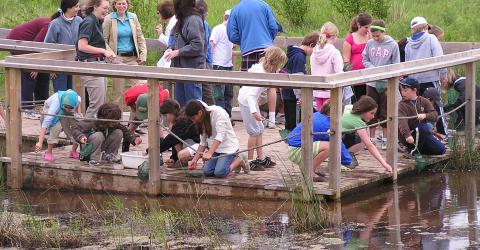
CEPA resources and activities
The biggest CEPA outreach activity takes place every 2 February since 1997, the Convention’s annual World Wetlands Day campaign uniting the Convention on Wetlands' global community in activities to raise awareness of the value of wetlands.
You can improve your communication, education, participation and capacity building techniques from the wide range of tools and materials available below.
Also on this page you will find key documents related to CEPA including guidelines documents, CEPA Programmes (Resolutions) and CEPA Action Plans from various countries.
Action plans and guidelines
Guidance was prepared for Contracting Parties and other CEPA practitioners, to assist in the CEPA action planning process. It provides an easy-to-use practical tool that will guide practitioners in organising well-designed and well-run participatory action planning processes that employ a range of techniques for facilitating diverse multi-stakeholder groups. A Guide to Participatory Action Planning and Techniques for Facilitating Groups is available for download below.
CEPA practitioners will also find useful a CEPA toolkit prepared by CBD. In this publication you will find tools concerning where, when and how to use a range of education and communication interventions.
Below you will also find examples of CEPA Action Plans that might serve as an inspiration and encouragement.
Handbook 6: People and Wetlands: The Convention on Wetlands CEPA Programme
A Guide to Participatory Action Planning and Techniques for Facilitating Groups
CEPA: A Toolkit for National Focal Points and NBSAP Coordinators
CEPA actions in site management plans: Laos PDR - Beung Kiat Ngong
CEPA National Action Plan: France
CEPA National Action Plan: Norway
CEPA National Action Plan: Mexico
CEPA National Action Plan: China
CEPA Site Action Plan: Malaysia - Lower Kinabatangan-Segama Wetlands
Wetland CEPA methods
The publications below document a broad range of CEPA methodologies not all of which are focussed on wetlands. They cover Communication techniques; Communication with a focus on visitor centres; Participatory techniques and capacity building; and Methods in environmental education/ education for sustainability.
Communication techniques
Communicating Sustainability: How to produce effective public campaigns
Successful Communication: A toolkit for researchers and civil society organisations
Communication with a focus on Wetlands Education Centres
Challenge for visitor centres: linking local people, visitors and protected areas
Participatory techniques and capacity building
Empowering the Grassroots: BirdLife, Participation, and Local Communities
A Guide to Participatory Action Planning and Techniques for Facilitating Groups
Enhancing the Wise Use of Wetlands: A Framework for Capacity Development
Participation, Consensus Building and Conflict Management Training Course
Learning together to manage together: Improving participation in water management
Environmental education / education for sustainability
Ranger Interpretation Handbook
Enabling Ecoaction: a handbook for anyone working with the public on conservation
Education for Sustainable Development Toolkit
Education for Sustainability. From Rio to Johannesburg: Lessons learnt from a decade of commitment
Environmental Education for a Sustainable Future: Australian National Action Plan
Educational materials
Useful resources:
Australian Government Water education resources
Discovering wetlands in Australia
United States Geological Survey Water cycle pages
United States Geological Survey Water Science School
United States marine debris program